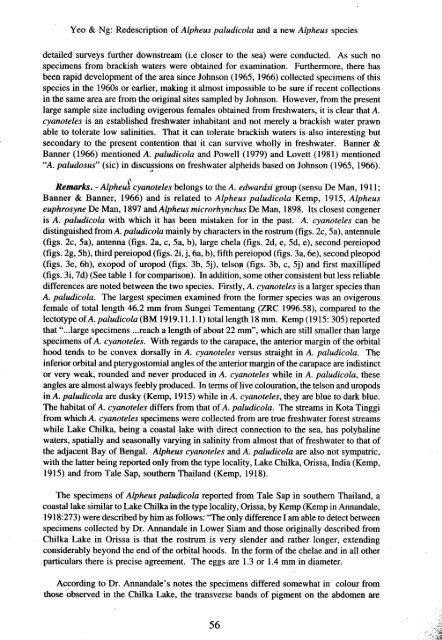a new species of freshwater snapping shrimp, alpheus cyanoteles
a new species of freshwater snapping shrimp, alpheus cyanoteles
a new species of freshwater snapping shrimp, alpheus cyanoteles
You also want an ePaper? Increase the reach of your titles
YUMPU automatically turns print PDFs into web optimized ePapers that Google loves.
detailed surveys further downstream (i.e closer to the sea) were conducted. As such no<br />
specimens from brackish waters were obtained for examination. Furthermore, there has<br />
been rapid development <strong>of</strong> the area since Johnson (1965, 1966) collected specimens <strong>of</strong> this<br />
<strong>species</strong> in the 1960s or earlier, making it almost impossible to be sure if recent collections<br />
in the same area are from the original sites sampled by Johnson. However, from the present<br />
large sample size including ovigerous females obtained from fresh waters, it is clear that A.<br />
<strong>cyanoteles</strong> is an established <strong>freshwater</strong> inhabitant and not merely a brackish water prawn<br />
able to tolerate low salinities. That it can tolerate brackish waters is also interesting but<br />
secondary to the present contention that it can survive wholly in <strong>freshwater</strong>. Banner &<br />
Banner (1966) mentioned A. paludicola and Powell (1979) and Lovett (1981) mentioned<br />
"A. paludosus" (sic) in discussions on <strong>freshwater</strong> alpheids based on Johnson (1965, 1966) .<br />
..<br />
Remarks. - Alpheui' <strong>cyanoteles</strong> belongs to the A. edwardsi group (sensu De Man, 1911;<br />
Banner & Banner, 1966) and is related to Alpheus paludicola Kemp, 1915, Alpheus<br />
euphrosyne De Man, 1897 and Alpheus microrhynchus De Man, 1898. Its closest congener<br />
is A. paludicola. with which it has been mistaken for in the past. A. <strong>cyanoteles</strong> can be<br />
distinguished from A. paludicola mainly by characters in the rostrum (figs. 2c, 5a), antennule<br />
(figs. 2c, 5a), antenna (figs. 2a, c, 5a, b), large chela (figs. 2d, e, 5d, e), second pereiopod<br />
(figs. 2g, 5h), third pereiopod (figs. 2i,j, 6a, b), fifth pereiopod (figs. 3a, 6e), second pleopod<br />
(figs. 3e, 6h), exopod <strong>of</strong> uropod (figs. 3b, 5j), telsoJl (figs. 3b, c, 5j) and first maxilliped<br />
(figs. 3i, 7d) (See table 1 for comparison). In addition, some other consistent but less reliable<br />
differences are noted between the two <strong>species</strong>. Firstly, A. <strong>cyanoteles</strong> is a larger <strong>species</strong> than<br />
A. paludicola. The largest specimen examined from the former <strong>species</strong> was an ovigerous<br />
female <strong>of</strong> total length 46.2 mm from Sungei Tementang (ZRC 1996.58), compared to the<br />
lectotype <strong>of</strong> A. paludicola (BM 1919.11.1.1) totallength 18 mm. Kemp (1915: 305) reported<br />
that " ...large specimens ...reach a length <strong>of</strong> about 22 mm", which are still smaller than large<br />
specimens <strong>of</strong> A. <strong>cyanoteles</strong>. With regards to the carapace, the anterior margin <strong>of</strong> the orbital<br />
hood tends to be convex dorsally in A. <strong>cyanoteles</strong> versus straight in A. paludicola. The<br />
inferior orbital and pterygostomial angles <strong>of</strong> the anterior margin <strong>of</strong> the carapace are indistinct<br />
or very weak, rounded and never produced in A. <strong>cyanoteles</strong> while in A. paludicola, these<br />
angles are almost always feebly produced. In terms <strong>of</strong>live colouration, the telson and uropods<br />
in A. paludicola are dusky (Kemp, 1915) while in A. <strong>cyanoteles</strong>, they are blue to dark blue.<br />
The habitat <strong>of</strong> A. <strong>cyanoteles</strong> differs from that <strong>of</strong> A. paludicola. The streams in Kota Tinggi<br />
from which A. <strong>cyanoteles</strong> specimens were collected from are true <strong>freshwater</strong> forest streams<br />
while Lake Chilka, being a coastal lake with direct connection to the sea, has polyhaline<br />
waters, spatially and seasonally varying in salinity from almost that <strong>of</strong> <strong>freshwater</strong> to that <strong>of</strong><br />
the adjacent Bay <strong>of</strong> Bengal. Alpheus <strong>cyanoteles</strong> and A. paludicola are also not sympatric,<br />
with the latter being reported only from the type locality, Lake Chilka, Orissa, India (Kemp,<br />
1915) and from Tale Sap, southern Thailand (Kemp, 1918).<br />
The specimens <strong>of</strong> Alpheus paludicola reported from Tale Sap in southern Thailand, a<br />
coastal lake similar to Lake Chilka in the type locality, Orissa, by Kemp (Kemp in Annandale,<br />
1918:273) were described by him as follows: "The only difference I am able to detect between<br />
specimens collected by Dr. Annandale in Lower Siam and those originally described from<br />
Chilka Lake in Orissa is that the rostrum is very slender and rather longer, extending<br />
considerably beyond the end <strong>of</strong> the orbital hoods. In the form <strong>of</strong> the chelae and in all other<br />
particulars there is precise agreement. The eggs are 1.3 or 1.4 mm in diameter.<br />
According to Dr. Annandale's notes the specimens differed somewhat in colour from<br />
those observed in the Chilka Lake, the transverse bands <strong>of</strong> pigment on the abdomen are
















